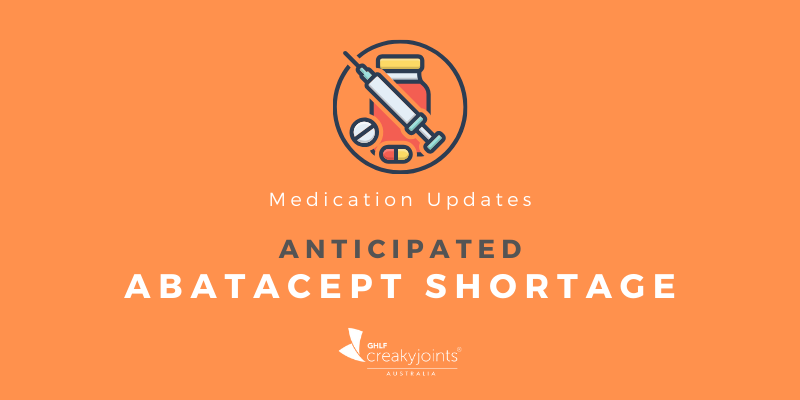

Saturday 6 May 2023 is World Axial Spondyloarthritis (axSpA) Day. AxSpA affects millions of people around the world. #WorldASDay2023 aims to raise the profile of this disease and increase awareness of the impact it has on people’s lives, physically, mentally and emotionally.
To spread awareness of this chronic autoimmune condition and to help dispel the myths surrounding it, we have adapted, with permission, a corresponding 2021 article by Teresa Dumain on the CreakyJoints US website. Some content may have been changed to suit our Australian audience.
Pronouncing axial spondyloarthritis (AK-see-ul Spon-duh-low-aar-THRAI-tuss, for what it’s worth) isn’t the most complicated thing you’ll face when learning about this inflammatory condition. Axial spondyloarthritis (axSpA) is tricky to learn about because it’s not exactly a household name — not many people have heard about it, let alone know much about managing it — and because there are many myths about axSpA.
Misconceptions about who gets axSpA, its symptoms, treatment and more can harm those who suspect they may have it or who are already living with it.
So, let’s start with some basics: Axial spondyloarthritis (axSpA) is an umbrella term for types of inflammatory arthritis that primarily affect the spine and the sacroiliac joint, which connects the bottom of the spine to the pelvis. The term axial spondyloarthritis is fairly new, according to Petros Efthimiou, MD, a rheumatologist at New York Rheumatology Care in New York City.
“Before, we would only speak about ankylosing spondylitis. Then we realised that’s only one subgroup, and there’s an equally big, or even bigger, group that’s non-radiographic but on the same spectrum of disease.”
As Dr Efthimiou says, there are two types of axial spondyloarthritis:
- Non-radiographic axial spondyloarthritis (nr-axSpA), which is when there are symptoms of axSpA, but damage to the joints is not visible on an X-ray.
- Ankylosing spondylitis (AS), which is when there are symptoms of axSpA and damage to the joints is visible on an X-ray.
Rajat Bhatt, MD, a rheumatologist at Prime Rheumatology PLLC in Richmond, Texas, says that nr-axSpa will eventually progress to AS in some patients, but not all.
This is just one of the many confusing elements of axial spondyloarthritis.
“We don’t know the natural history of the disease very well yet,” Dr Bhatt says. Experts do know that there is no cure for this inflammatory disease with an impossible name. There are, however, some treatments that can ease pain, reduce joint damage and may prevent or delay long-term complications. And increasing awareness — as well as knowing facts from fiction — may help people with axSpA get treatment sooner rather than later.
Below, we clear up some common axial spondyloarthritis myths that can be harmful to patients.
Myth: Axial Spondyloarthritis is Rare
Fact: AxSpA is about as common as rheumatoid arthritis
A disease is considered “rare” if it affects fewer than 200,000 people. According to a widely cited study that aimed to establish the national prevalence of spondylarthritis in the US, about 2.7 million Americans or more are affected by axSpA. That’s about the same as for rheumatoid arthritis, according to researchers. Within that group, half will have non-radiographic axial spondyloarthritis and half will have ankylosing spondylitis. What’s more, these numbers may be an underestimate, according to researchers, because the data set on which they are based did not capture all the information included in common classification criteria for axSpA. (Classification criteria are a set of symptoms and characteristics that a patient must have in order to be considered to have a condition.)
Myth: Axial Spondyloarthritis is a ‘Man’s Disease
Fact: Women get axSpA too
It’s true that, historically, ankylosing spondylitis was considered a predominantly male disease. Early studies estimated for every 10 men with axSpA, only one woman had it. Newer findings, however, suggest the male-to-female ratio is much closer at 3:1. Additionally, the prevalence of non-radiographic axial spondyloarthritis is equal among the sexes.
“We know now that nr-axSpA is just as common in women, so we don’t think of axSpA as man’s disease,” says Dr Efthimiou.
That said, physician bias may exist, resulting in it taking longer for the disease to be diagnosed in women, as noted in a 2018 study published in PLOS One. For example, doctors may be less likely to suspect axSpA in women who present with symptoms; they may chalk it up to back pain due to other causes or another condition that causes widespread pain, like fibromyalgia.
But it’s not just the potential physician bias that causes delayed or fewer axSpA diagnoses in women. A 2018 review of axSpA patient data found that women may exhibit different symptoms of axial spondyloarthritis symptoms than men. For example, back pain may not be as prominent in women with axSpA; instead, they may feel more pain in their neck and shoulders, or peripheral joints, like the knees.
Additionally, the 2018 review found that women are more likely to exhibit extra-articular manifestations (EAM) — conditions and symptoms not associated with the musculoskeletal system — such as enthesitis, psoriasis and inflammatory bowel disease (IBD). These symptoms may lead women to seek other kinds of treatment — say, seeing a podiatrist for inflammation of a tendon in the foot — and experience delays in getting diagnosed with axSpA.
Myth: Axial Spondyloarthritis Mostly Affects Older People
Fact: AxSpA typically starts young
When many people hear about symptoms like arthritis and back pain, they immediately assume it’s an “old person” problem. But that’s not the case with axSpA. In fact, getting chronic back pain at a young age is a red-flag symptom of inflammatory back pain, the kind involved in axSpA.
“[Axial spondyloarthritis] generally starts in people during their teens or in their twenties, or maybe in their thirties,” Atul A. Deodhar, MD, Professor of Medicine and the Medical Director of Rheumatology Clinics at Oregon Health & Sciences University in Portland, Oregon, previous told CreakyJoints. “Almost always, the disease starts before age 40.”
But being younger, combined with not knowing about axial spondyloarthritis, is also a recipe for being misdiagnosed. People in their teens, 20s and 30s who start experiencing back pain may chalk up their symptoms to mechanical causes, like an exercise or sports injury. They may also be more likely to start treating their back pain with things like chiropractic care or massage therapy, further delaying the path to a diagnosis.
Myth: Axial Spondyloarthritis Only Affects Your Back
Fact: AxSpA may also impact your feet, eyes, gut and more
The most common axSpA symptom is pain and stiffness in the lower back, resulting from inflammation in either the sacroiliac joints, the spine or both.
But other joints can be affected by axSpA too, including your neck and shoulders, hips and knees and between the spine and ribs. It can also cause inflammation in the places where your tendons and ligaments attach to bones. This condition is called enthesitis and tends to affect the back of your heel (where it can be mistaken for Achilles tendinitis) and the sole of your foot (where it can be mistaken for plantar fasciitis).
What’s more, axSpA isn’t just a joint issue. Systemic inflammation from axSpA can affect your eyes, leading to a painful condition called uveitis, which can cause redness, pain and sensitivity to light. Fatigue and sleeplessness can also occur — back pain that disrupts your sleep, especially in the second half of the night is also a tell-tale axSpA symptom. AxSpA is also associated with dactylitis (a condition where fingers and toes swell to the point of resembling sausages), psoriasis, inflammatory bowel diseases such as Crohn’s and ulcerative colitis and an increased risk of cardiovascular disease. People with axSpA are also more likely to have anxiety and depression.
It’s important to be aware of all these other ways axSpA can affect the body because seemingly unrelated symptoms can help clinch a diagnosis. For example, you might not think there’s any connection between back pain and psoriasis, or between your achy ankle and gastrointestinal upset.
Myth: Resting Will Ease Pain and Stiffness From Axial Spondyloarthritis
Fact: Rest may exacerbate or worsen your axSpA back pain
Axial spondyloarthritis is an inflammatory disease, which means the inflammation is a result of your immune system attacking your body’s own tissues. The inflammation that causes axSpA pain is different to the aches and pains you feel after lifting something heavy or sleeping on a bad mattress. That type of pain is known as mechanical pain, which happens when there’s been a disruption in the way the components of the back (the spine, muscle, intervertebral discs and nerves) fit together and move.
Since there are different causes of these two pains, it stands to reason that there are different approaches to managing the pain as well. With mechanical pain, for example, Dr Bhatt says movement aggravates nerve endings. If your pain is severe and you’re experiencing muscle spasms, Cleveland Clinic notes that your doctor may recommend short-term bed rest; otherwise, over-the-counter pain relievers with some rest may be all you need. With inflammatory pain, however, “movement increases circulation which improves and washes out the painful cytokines,” explains Dr Bhatt.
Myth: A Simple Test Can Confirm an Axial Spondyloarthritis Diagnosis
Fact: No one test can be used to diagnose axSpA
The process for testing and diagnosing axSpA is far from simple. It’s not as though you can walk in, get a blood test, and find out you have axSpA, the way you can, say, with diabetes.
Research shows that it can take an average of almost seven years for someone to be diagnosed with axSpA, according to a review published in the journal Rheumatology. There are many possible explanations for this, starting with the fact that many people don’t know what axSpA is or suspect it as a cause of their symptoms.
“About 90 per cent of adults will experience low back pain at some point in their lives,” says Dalit Ashany, MD, a rheumatologist at Hospital for Special Surgery in New York City. “For physicians not familiar with (axial spondyloarthritis) or not actively thinking about it, they may not pursue the proper tests.”
But even if your physician is familiar with axSpA, or you go to a rheumatologist from the start, it still may take a while to get diagnosed because, according to Dr Efthimiou, “there’s no diagnostic test or specific progression of axSpA.”
So how does your doctor determine if you have axSpA? There are several tests they will perform, including:
- A physical examin which your doctor will look for signs of spine fusion by testing your range of motion and chest expansion during breathing.
- Image testing, which will likely include X-rays and MRIs. The X-rays will be used to assess potential fusion or damage to the joint and bones. The MRIs will help identify any swelling in the bone marrow and can pick up inflammation in the soft tissues in the bones and around the joints.
- Assessment of personal and family medical history
- Blood workto test for HLA-B27, a genetic marker for axial spondyloarthritis (more on that below, as well as inflammatory markers like CRP and ESR.
Myth: A Genetic Test Can Reveal if You Have Axial Spondyloarthritis
Fact: There is a genetic marker associated with axSpA, but you can have axSpA without the genetic marker
According to the American College of Rheumatology, HLA-B27 is the most common genetic marker associated with axSpA. It is a form of the HLA-B gene, which provides instructions for making a protein that sits on the surface of cells. This gene helps your immune system determine which proteins it comes in contact with are from your own body and which are foreign and potentially dangerous, such as viruses and bacteria. It is unclear how HLA-B2 contribute to axSpA and other inflammatory or autoimmune disorders.
So, if you test negative for HLA-B27 you’re in the clear, right? Wrong. Dr Efthimiou says you can test negative for HLA-B27 and still have axSpA. Research has shown HLA-B27 occurs less in African Americans, for example, yet Black people with AS have more severe disease, compared to White people or Latinos. And on the flip side, having the HLA-B27 gene doesn’t guarantee you will develop axSpA.
Bottom line: AxSpA is a complex disease that’s not caused only by one gene, but a mix of genetic, environmental and other risk factors.
Myth: If You Have Non-Radiographic Axial Spondyloarthritis, it Will Eventually Develop Into Ankylosing Spondylitis
Fact: Not everyone with non-radiographic axial spondyloarthritis develops ankylosing spondylitis
A 2019 study published in the journal Current Opinion in Rheumatology indicates up to 40 per cent of patients with non-radiographic axial spondyloarthritis progress to ankylosing spondylitis over two to 10 years. That means the majority of people do not develop structural changes in the sacroiliac joints and progress to AS, at least not quickly.
There’s no way to know for sure who will develop AS and who won’t, says Dr Efthimiou. “There are patients who not only don’t progress, but the symptoms resolve on their own or the patient goes into remission.” Certain characteristics, however, may help predict worse outcomes, says Dr Ashany. Risk factors for progression to AS include the male sex, elevated inflammatory markers, presence of the HLA-B27 gene and degree of inflammation seen on MRI of the SI joints. Still, even with these risk factors, not all patients progress, she says.
Myth: NSAIDs Won’t Help Treat Axial Spondyloarthritis
Fact: NSAIDs are the first line of treatment for axSpA, but they’re not your only option
Non-steroidal anti-inflammatory drugs, or NSAIDs, work to relieve pain and stiffness and reduce inflammation — and tend to be underused for treatment, says Dr Bhatt. “Quite often, people think NSAIDs are not effective, but that’s not the case,” he says. NSAIDs (such as naproxen, ibuprofen, meloxicam or celecoxib) remain the first line of treatment for axSpA, according to the American College of Rheumatology. That said, prolonged use of NSAIDs, especially in high doses, may come with side effects and risks.
Some of the most commonly reported side effects, according to the Cleveland Clinic, include stomach and gut symptoms, like gas and bloating, stomach pain and nausea. NSAIDs may also increase your risk of ulcers and bleeding in the GI tract, as well as heart and kidney problems, according to healthdirect.
If NSAIDs aren’t effectively treating your symptoms, your doctor may suggest starting a biologic medication, such as a tumour necrosis factor (TNF) inhibitor or an interleukin-17 (IL-17) inhibitor. Examples of TNF medications include adalimumab (Humira®), certolizumab pegol (Cimzia®), etanercept (Enbrel®), and golimumab (Simponi®) and infliximab (Remicade®).
Examples of IL-17 inhibitors include ixekizumab (Taltz®) and secukinumab (Cosentyx®).
These medications target specific parts of your immune system to reduce inflammation and ease axSpA symptoms. They are given as either injections or infusions.
You should talk to your doctor about all the potential risks and side effects of your medications.
Myth: Only Medications Can Ease AxSpA Pain
Fact: Physical activity is an important part of managing axSpA
“Many patients have an overoptimistic view of medications,” says Dr Bhatt. “They don’t engage in physical activity, thinking meds will take care of all the pain. But medications need to be used in conjunction with physical therapy and home exercise.”
That’s because regular physical activity can help relieve pain through circulation, as Dr Bhatt previously explained, and improve strength and flexibility. Exercises like yoga help to keep the spine mobile and build core strength, which Dr Efthimiou says is essential to maintaining your range of motion with axSpA.
Before beginning any new exercise program, talk to your doctor to make sure it’s appropriate and safe for you. Your doctor also may recommend working with a physiotherapist, who can help strengthen your muscles and teach you techniques that protect joints from further damage.
Myth: You Must Follow a Specific Diet When Diagnosed With Axial Spondyloarthritis
Fact: There’s no one diet for axSpA, but certain foods may help you feel better
“There are no flawless studies to show that any particular diet makes a difference in symptoms,” says Dr Ashany. “However, if a patient tells me that if they eat a particular food they feel much worse, then I tell them to avoid that particular food.”
Eating anti-inflammatory foods, in conjunction with the right treatment, may offer additional benefits, adds Dr Efthimiou. Consider the plant-based Mediterranean diet, which is high in fruits, vegetables, nuts, whole grains, fish and healthy oils. And limit or avoid foods that cause inflammation, such as refined carbs, fried foods, red meats and sugar-sweetened drinks.
Myth: Axial Spondyloarthritis Will Leave You Hunchbacked and in a Wheelchair
Fact: Though axSpA can cause permanent damage and structural changes to the spine, this can be avoided
Ankylosing spondylitis is an inflammatory disease that, over time, can cause some of the small bones in your spine to fuse. This fusing makes the spine less flexible and can result in a hunched-forward posture. But AS doesn’t progress at the same rate or in the same way in everyone.
“Patients have variable courses,” says Dr Ashany. “Some are never destined to develop progression or significant symptoms and have quite a mild disease.”
And the outlook for patients with AS is much better today than it was even just, say, 15 years ago.
“These days we can do a lot to help prevent damage,” says Dr Efthimiou. With a combination of medications, exercise and lifestyle changes, you can manage symptoms and help delay or prevent progression. Earlier detection helps as well, Dr Efthimiou says, noting that, “the earlier we can diagnose a patient, the more likely we can alter the natural pace of the disease and help prevent damage.”
This information should never replace the information and advice from your treating doctors. It is meant to inform the discussion that you have with healthcare professionals, as well as others who play a role in your care and well-being.
Join the CreakyJoints Australia Community
Becoming a CreakyJoints Australia member takes just a few minutes. You’ll receive our members’ e-newsletter featuring:
- Reliable information about arthritis types and treatments.
- Tips for managing daily life with arthritis and related conditions.
- Personal stories from people living with similar conditions to you.
- Links to our podcasts featuring interviews with health clinicians and patients.
- Surveys to help us discover what’s important to you.
Follow us on Facebook
We set up our CreakyJoints Australia Community group on Facebook to share our latest news, feature articles, arthritis resources and other content with you. We invite you to provide feedback on any of our posts and chat with each other in the comments. You are also welcome to share ideas about the content you would like us to create or share practical tips for living with arthritis and related conditions.
Keep Reading
- 10 Things to do After an Arthritis Diagnosis: Top Tips From Patients
- A Patient’s Guide to Living with Axial Spondyloarthritis in Australia
- Medicinal and Non-Medicinal Arthritis Treatments
- Government Support for People With Chronic Conditions
- How to Access Holistic Allied Health and Rheumatology Support Online
Sources
Non-Steroidal Anti-Inflammatory Drugs (NSAIDs). Healthdirect. https://www.healthdirect.gov.au/anti-inflammatory-medicines#side-effects
Interview with Dalit Ashany, MD, rheumatologist at Hospital for Special Surgery in New York
Interview with Petros Efthimiou, MD, rheumatologist at NY Rheumatology Care in New York
Interview with Rajat Bhatt, MD, rheumatologist at Prime Rheumatology PLLC in Richmond, Texas
Jamalyaria F, et al. Ethnicity and disease severity in ankylosing spondylitis a cross-sectional analysis of three ethnic groups. Clinical Rheumatology. August 6, 2017. doi: https://doi.org/10.1007/s10067-017-3767-6.
Jovani V, et al. Challenges to conquer from the gender perspective in medicine: The case of spondyloarthritis. PLOS One. October 12, 2018. doi: https://doi.org/10.1371/journal.pone.0205751.
Non-Steroidal Anti-Inflammatory Drugs (NSAIDs). Cleveland Clinic. January 25, 2020. https://my.clevelandclinic.org/health/drugs/11086-non-steroidal-anti-inflammatory-medicines-nsaids.
Pain relief: Taking NSAIDs safely. Harvard Health Publishing. September 1, 2013. https://www.health.harvard.edu/pain/pain-relief-taking-nsaids-safely.
Rare Diseases FAQ. National Human Genome Research Institute. January 10, 2020. https://www.genome.gov/FAQ/Rare-Diseases.
Reveille JD, et al. Prevalence of Axial Spondylarthritis in the United States: Estimates From a Cross-Sectional Survey. Arthritis Care and Research. January 24, 2012.
oi: https://doi.org/10.1002/acr.21621.
Rusman T, et al. Sex and gender differences in axial spondyloarthritis: myths and truths. Rheumatology. October 14, 2020. doi: https://doi.org/10.1093/rheumatology/keaa543.
Rusman T, et al. Gender Differences in Axial Spondyloarthritis: Women Are Not So Lucky. Current Rheumatology Reports. May 12, 2018. doi: https://doi.org/10.1007/s11926-018-0744-2.
Wang R, et al. EPIDEMIOLOGY OF AXIAL SPONDYLOARTHRITIS: AN UPDATE. Current Opinion in Rheumatology. March 2018. doi: https://doi.org/10.1097/BOR.0000000000000475.




